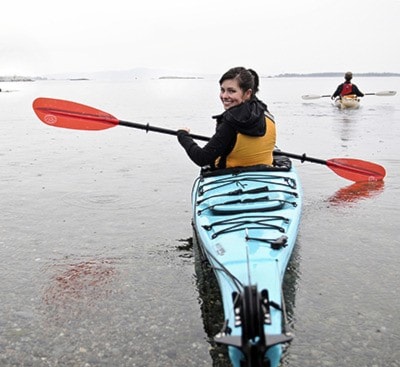You kind of have to make peace with how much it tips,” Rita tells me.
The kayak jostles against the waves, my expression as uncertain as my paddle. A little squeak escapes my mouth as my body jerks to correct the plastic boat from tipping into the ocean. I feel like an overweight cat balancing on a thin fence. Then, I exhale and get my grip.
The instructions on land are easy: how to squat into the kayak, how to position the foot rests, hold the paddle and leverage it low and long, how to adjust the water skirt and how to rip it off in an emergency. On the water, all that really sticks – at first – is instinct.
That’s where Rita Slanina, principal guide and co-manager of Blackfish Sea Kayak Adventures, comes in. Slanina has been guiding tourists and locals into the water for the last five years, and part of the process is beating instincts that would sink you.
To turn your kayak, many people will try to paddle in the direction they want to go, Slanina tells me. Really, it’s about where you aren’t paddling. You have to do the opposite.
Guiding comes down to more than just the technicals. Blackfish, like many kayak tour companies on the Island, specializes in taking paddlers where they’ve never been before. Originated by wilderness thrill seeker Al Lubkowski, Blackfish is currently one of the only kayak touring companies on the sea side of the South Island. With Slanina’s lead, the company offers day tours out of Oak Bay, Discovery Island and Saanich Inlet, overnight camping tours to Discovery Island and the Gulf Islands, two-day trips out of Port Renfrew, five day adventures in Barclay Sound, even bonus whale watching, bird watching and customized routes. Though, as Slanina will tell you, the Discovery-Chatham Islands — which all sit within a 45-minute paddle from the Oak Bay base — offer what many consider to be the best paddling around.
It’s easy to see why. With all the basics covered, we head around the tip of the Oak Bay Marina, past vessels, seagulls, kelp plants and a few curious seals. A light rain decorates the water as we glide out, each stroke becoming easier than the last. Within 10 minutes, I can see what Slanina is talking about — soon, my body stops fighting the unstable movement. My legs melt into the plastic sides, the oars become my arms. I am the kayak.
Slanina herself is a coastal creature. Folks tease she was born with a paddle in her hands, as the 23-year-old grew up poking and prodding through the tidal pools of Victoria’s coastline. With her years of experience, Slanina has guided tours of Victoria’s Inner Harbour and the Gorge Waterway, she’s coached dragon boat teams and lead children’s nature programs on Esquimalt Lagoon.
In 2009, she discovered Pender Island’s marine park and waterways, and spent the following three summers honing her instructing skills.

Now, she plans to guide the helm of Lubkowski’s company into the future.
There are days, she tells me, when she spends 11 hours on the water; times when her arm muscles get “pretty intense.” Those are the days she has to balance everything out with a long hike or, she says, her legs would turn to mush.
Aside from the thrill of the ocean, Lubkowski and Slanina share a philosophy around what kayaking is really about: creating an awareness and respect for the Island’s unique marine environment.
“It’s amazing to be able to float up to these protected islands that we aren’t allowed to walk on and get to see them up close in a way that doesn’t disturb anything,” Slanina tells me as we float up to one such area — “Jimmy Chicken Island.” Better known nowadays as Mary Tod Island, history claims this little dot of land aside the marina used to be home to a man in the mid-1800s who made a living fishing, drinking and stealing chickens. Some decades after his death, a spark from a celebratory fireworks show burned all the remaining structures on the island away.
Now, the land is protected — and stories like this are all part of the adventure for Slanina, who eddies between historian and environmental expert.
Two hours of photos, floating and talking have passed and the kayak feels as natural as my own skin — though my shoulders dispute this. The gentle spik, spik of rain on water applauds us back to the shore, and my legs are a foreign weight as my arms pull my body out of the boat.
